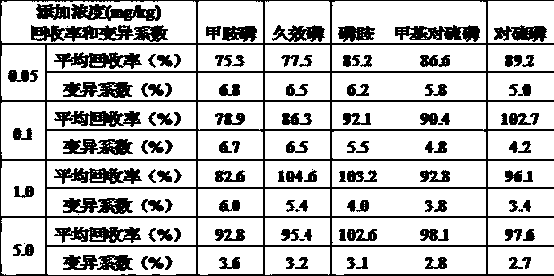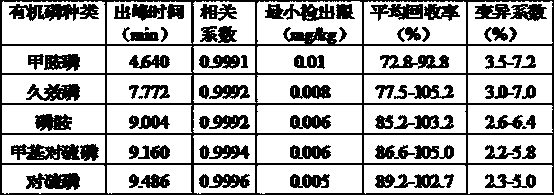Gas chromatographic method for detecting residues of high-toxic organophosphorus pesticides in soil
An organophosphorus pesticide and gas chromatography technology, applied in the field of pesticide residue detection, can solve problems affecting biological activities, pollution of agricultural products, ecological safety and water environment safety, etc., and achieve the goal of simplifying the pretreatment process, saving costs and shortening the detection time Effect
- Summary
- Abstract
- Description
- Claims
- Application Information
AI Technical Summary
Problems solved by technology
Method used
Image
Examples
Embodiment Construction
[0029] Method 1: Detection of five highly toxic organophosphorus pesticide residues in clay
[0030] (1) Pretreatment of clay soil samples
[0031] ①Extraction Use an electronic balance to accurately weigh 15.0g of soil sample into a 250ml Erlenmeyer flask with a stopper, add 15ml of distilled water and 50ml of acetonitrile, vibrate at 200r / min for 30min on a water bath (25±1)°C shaker, then filter with absorbent cotton , the filtrate was collected in a 100 ml stoppered graduated cylinder containing 7 g of sodium chloride, shaken vigorously for 1 min, and allowed to stand at room temperature for 30 min to separate the acetonitrile and aqueous phases;
[0032] ②Purification Draw 10.0 ml of acetonitrile solution from a 100 ml stoppered cylinder into a 15 ml graduated test tube, heat the test tube in a water bath, control the temperature of the water bath at 65°C, and slowly pass nitrogen or air into the test tube, When the sample solvent is volatilized and concentrated to near ...
PUM
| Property | Measurement | Unit |
|---|---|---|
| recovery rate | aaaaa | aaaaa |
| recovery rate | aaaaa | aaaaa |
| coefficient of variation | aaaaa | aaaaa |
Abstract
Description
Claims
Application Information
 Login to View More
Login to View More - R&D
- Intellectual Property
- Life Sciences
- Materials
- Tech Scout
- Unparalleled Data Quality
- Higher Quality Content
- 60% Fewer Hallucinations
Browse by: Latest US Patents, China's latest patents, Technical Efficacy Thesaurus, Application Domain, Technology Topic, Popular Technical Reports.
© 2025 PatSnap. All rights reserved.Legal|Privacy policy|Modern Slavery Act Transparency Statement|Sitemap|About US| Contact US: help@patsnap.com



